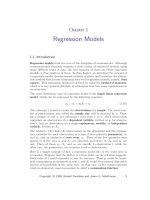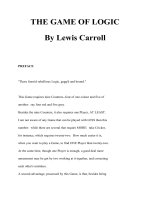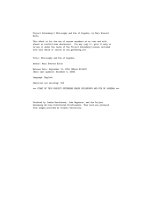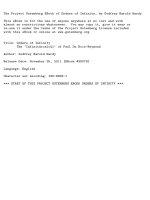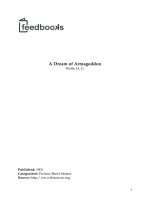Preservation of some invariants of modules by specialization
Bạn đang xem bản rút gọn của tài liệu. Xem và tải ngay bản đầy đủ của tài liệu tại đây (2.35 MB, 8 trang )
<span class='text_page_counter'>(1)</span><div class='page_container' data-page=1>
VNU. J OU R N A L OF SCIENCE. M a t h e m a t i c s - Physics t XVIII. n ° l - 2002
P R E S E R V A T IO N O F S O M E I N V A R I A N T S
O F M O D U L E S B Y S P E C I A L I Z A T I O N
<b>Dam Van Nhi</b>
<i>Pedagogical College. </i> <i>T h a i B in h ' V ietn a m</i>
<b>Introduction</b>
Throughout 11 ii> paper wo assume that <i>k</i> is an arbitrary perfect infinite field, and <i>K</i>
<b>is an extension o f A*. We denote? </b><i>R</i><b> := A:(w.) [jt'3, and </b><i>Rn</i><b> :== A:(a)[.rj. w here </b><i>It</i><b> = (ỉ</b>/ 1<b>...</b><i>Uut)</i>
is a family of indeterminate and o = ( a i...<i>(\,n)</i> € <i>I \ fn•</i> III this paper, we shall say that
a property holds for almost all rt if it holds for all <i>a</i> except perhaps those lying on a proper
<b>algebraic subvariety o f A'"\ For other n otations we refer the reader to [1Ị. For convenience </b>
we often ohmit. tile phrase “for almost all <i>a "</i> when we are working with specializations.
The theory of specialization of ideals was introduced by w . Krull [5j. [()]. Krull
defined the specialization of an ideal / of <i>R</i> with respect to the substitution <i>u</i> -4 a as th<‘
ideal /,, = { / ( o<i>sX)</i> ị <i>f ( i t . x ) €</i> /nfcjtt,./:]}. The ideal <i>I n</i> inherits most of the basic properties
of /. Using specializations of finitely generated free modules and homoinorphisms between
them wo defined in (7j the specialization of finitely generated module. We showed that
the basic properties and operations oil modules are preserved by specializat ions. In [8] we
followed the1 samr approach to introduce and to study specializations of finitely generated
modules OVCT a local ring.
The aim of this paper is to show that some invariants of finitely generated modules
over a local ring are preserved by specializations. We will show that tilt1 specializations
of a Gorcnstein (linear maximal Budisbaum) module is again Gorenstein (linear maximal
Buchsbaum).
<b>Preservation of some invariants of modules by specialization</b>
Let <i>p</i> be an arbitrary prime ideal of <i>R.</i> By [6, Satz 14], the specialization <i>p n</i> of <i>p </i>
is a radical nil mixed ideal. Let p he an arbitrary associated prime ideal of <i>Pn .</i> We consider
the specialization of finitely generated <i>R p -</i>module.
<b>For short we will pu t </b><i>s</i><b> = </b><i>R[></i><b> and </b><i>S (i = ( R (i)</i><b>p. D en ote </b><i>P S</i><b> and p</b><i>s ,ầ</i><b> by m and m0 . </b>
We start by recalling the definition of a specialization of a finitely generated 5-module.
<b>Let </b><i>L</i><b> be a finitely generated S-m od u le. A ssum e th a t</b>
<i><b>s'* A s ' — > L — > 0 </b></i>
be a finite free presentation of <i>L.</i> As the definition of <i>L a</i> we obtain a finite free presentation
<i><b>sil ^</b></i> <i><b> s ' — > L n — > 0,</b></i>
T y p e s e t by
</div>
<span class='text_page_counter'>(2)</span><div class='page_container' data-page=2>
IK <i><sub>D a m Van N h i</sub></i>
where <i>L n =</i> Cok<T0a, see [8].
The /th <i>B oss</i> and /til <i>B etti num bers</i> of <i>L.</i> which are denoted by //Ç(<i>L</i> ) and <i>3 ,</i>(<i>L ) </i>
respectively. aro defined as follows
<i>ụ?s(L) =</i><b> d i m E x t < ; ( S / m , L), Vi > 0.</b>
<i>0 i ( L )</i> = dim.s/ni Torf (S/m. />), V/ > 0.
Proposition 1.1. <i>Let L be</i> a <i>fin itely g en era ted S -n io d id c . Then, for nliiiost rill ( \ %</i> we
<i>fig</i> (L0 ) = <i>i i ‘s { L ) rind ( 3 i( L 0 )</i> = <i>f t i ( L ) , V i ></i> 0.
<i>Proof.</i> Since <i>L</i> is finitely generated, all integers <i>ị i l$ { L )</i> are finite. We have
/£(!) = i(Exti(S/m,L)).
<b>By [8. P roposition 3.3], there is</b>
<i><b>E x t s ( S J m0 , L „ ) a E x t</b></i>5 (57m, £ )„ .
Since <i>Pn</i> is a radical ideal, from [8, Proposition 2.8] it follows that
f(ExtjỗM (S,v/m,r, L0 )) = i(E x t^ (5 /m ,L )rt) * *(Ext’s(S/m . <i>L ) ) .</i>
Mona*
M ^ (L 0) = 4 ( L ) 1 i > 0 .
<b>Similar, we obtain</b>
<i>& { L „ ) = 0 i ( L ) , i ></i> <b> 0.</b>
We invoke Proposition 1.1 to reprove Corollary 3.8 in [8].
<b>C o r o lla r y 1 .2 . </b> <i>Let L be</i><b> a </b><i>finitely generated s-m odule . I f L is</i><b> a </b><i>Buchsbcium s - m o d u l e ' </i>
<i>then L n is also</i><b> a </b><i>Buchsbaum S n -module for almost</i><b> a/i a .</b>
<i>Proof.</i> Put <i>d</i> = dim L. By [8. Theorem 2.7], dim La = d. Since s is a regular ring, by 10.
Chapter 2. Theorem 4.2] we known that <i>L</i> is a Buchsbaum 5-module if and only if
/4 =
(S/mK(tfi(£)), Î = (),... ,d -
1.
j
= 0Since f(//m (L)) < (£<>)) = <i>V ( H m ( L ) )</i> by [8. Theorem 3.6]. Now the proof is
<b>im m ediately from P roposition 1.1.</b>
</div>
<span class='text_page_counter'>(3)</span><div class='page_container' data-page=3>
<i>P re se r v a tio n o f sortie in v a r ia n ts o f m o dules by sp e c ia liza tio n</i>
Lemma 1.3. <i>L('t L</i> />('• a <i>fin itely g c iic rn t e d S-mochilt'. T h e n</i>, <i>for almost CÌÌÌ</i> Ụ* <i>liỉìvo</i>
inj. <Iim(Ln ) = inj. dim(L).
<i>In Ị v ì r t ir u lỉir . i f I, is an in je c tiv f» m o d uli', then L n is also ỈÌÌÌ in jc c tiv e module.</i>
Proof. Sinn* /? and <i>R n</i> are Gorenstt'in rings, <i>s</i> and <i>S lt</i> are Gorenstein rin*>s by 1. Proposi
tion ÌỈ.1.19Ì. By [8, Theorem 3.1], we have proj. dim <i>L n</i> = proj.dim L < oc. and therefore
inj. dim /v,, and inj.diniL are finite. From 1. Theorem 3.1.17] we obtain
inj. dim <i>L (i</i> = depth <i>S n</i> = depth 5 = inj. dim <i>L .</i>
If <i>L</i> is an injective 5-module, then inj.diniL = 0. Hence inj.ciiinL,, = 0. and therefore'
<i>L n</i> is injective. By using this lemma we have the following theorem.
Theorem 1.4. <i>Let L be</i> a <i>fin ite ly gen era ted s -m o d u le . It L is a G o ìv iìs t e iìỉ S -iiio d u lc . </i>
<i>then L n is again a G oìvnsteiỉi S tt-ììio d uỉc fo r iihnost nil (X.</i>
<i>Proof.</i> Assume th a t <i>L</i> is a Gorenstoin S-module o f dimension equal <i>(L</i> Then <i>L</i> is a Cohon-
Macaulay .S’-module hv [9. (3.11)] and dim 5 = inj.diniL = <i>d.</i> By [8. Tlu’oivm 2.71.
dim <i>L n — <L</i> By js. Corolllary 3.2]. <i>L ix</i> is also Cohen-Macaulay. Since (liniô'o = dim <i>$</i> and
inj. dim <i>L t%</i> = inj. (lim <i>L</i> I)V Lmuna 1.3. wo havcMÌini <i>S tị</i> = ill), dim <i>L iX</i> = dim <i>L n .</i> Hence <i>L ix</i>
is also G orm stein.
Now \vr will show that the multiplicity of modulo is preserved by specialization. Wo
bogin with a following lemma.
Lemma 1.5- <i>Let L be H fin itely g enera ted S -n io d u le o f d im en sio n (I. L e t (J\</i>...<i>iffi h r</i>
a <i>svstciỉi o f param eters oïl L . T h e n</i> (vi)íYi-‘ - <i>>{y<i)<*</i> j*s <i>â system o f p a ra m e te rs oil</i> /,,, <i>for </i>
<i>almost till (I.</i>
<i>Proof.</i> Since <i>(J)</i>...<i>y,i</i> 6 <i>P S</i>, there are (vi , <i>{y(i)n</i> £ <i>P(*Six.</i> By Ị8, Lemma ‘2.3 and
Theorem 2.7], there is
dim <i>L n / ( { y \</i> )„ ...<i>(y ti ) n ) L n</i> = <lini(L/(//i...<i>y , i ) L ) n = d \ u i L / ( t j \</i>...<i>y ,i)L</i> - 0.
<b>Tilt'll </b><i>(y\</i><b> ),,...</b><i>(ijti)tt</i><b> i‘s a sy stem o f param eters Ü</b>11 <i>L n .</i>
Theorem 1.6. <i>L et L he</i> a <i>fin itely genvvnted S - in o d iile o f d im en sio n (I and lot</i>
q = (y i...<i>Vd)S</i>
<i>he</i> a <i>p a ra m e te r ideal on L . T h en , fo r almost</i> a<i>II</i> ft, we have
c (q „:L rt) = e(q;L),
U’lii'iv c(q,t:£ 0) and <*(q:L) are <i>the m u ltip lic itie s o f L a</i> and L <i>w ith respect to</i> q(l and q
<i>resp ectiv e ly.</i>
<i>Proof.</i> By [8, Theorem 2.7], ( lim L ,, = <i>d.</i> By Lemma 1.5, the ideal
</div>
<span class='text_page_counter'>(4)</span><div class='page_container' data-page=4>
:.o <i>D a m Van N h i</i>
is a parameter ideal oil L (V. The multiplicity symbol of <i>, y (Ị</i> with respect to <i>L</i> is
d e n o t e d b y <i>e ( y \ , . . . y y (i \ L ) ,</i> a n d t h e m u l t i p l i c i t y s y m b o l o f <i>( y</i> i ) t t , • • • , <i>( y<i )n</i> w i t h r e s p e c t
to L0 is denoted by <i>e { ( y</i> , (</r/)0 |Lfl ). We have
“ ^((ỉ/l 1(1! • • • 1 <i>{ ỉ j t l ) c ì </i> <i>L</i> <i>n</i> <i>) , </i>
<i><b>e(q: L) = t-(;vi...,VdỊL).</b></i>
wv* Iim l only show that
e( ( y i , ( » d ) a | ^ « ) = e(/yi.yfz|£).
Wo prove this claim by induction on <i>d.</i> For the case <i>d —</i> 0, bv applying [8. Proposition
2.8] w<‘ have
<i><b>e (0 |L fV) = f ( L ti) = f ( L) = e(0|L).</b></i>
Now we rtssunic tliat <i>d ></i> 1. and the claim is true for all S-module with dimension <i>< (I</i> 1.
By <i>[H,</i> Lrmma 2.3 and Lemma 2.5]. there are
<i>L n / { y i ) tiL n = ( L / y \ L ) n</i> and <i>0 L"</i> : (yi)o s* (0/, : <i>Ij\)n - </i>
Siiuv tin* dimension of these modules < <i>d</i> - 1, there are
f’( 0 / 2 <i><b>i{y<i)<x\L(x/ ( y \ ) n La ) = e(y-</b></i>2>ã ã ã .;ô/,/|L/?7iÊ).
<b>^('(lte)r... *(ù/ii)o|0/. : (ợ/i)ô) = e(y2ợ-.- */iớ|0l : A/i ).</b>
The statment follows from the définition of the multiplicity.
We now will show the preservation of some invariants of module which are given by
<b>N. T. C uoug in [2j.</b>
Recall that (-4. n) is a local ring and <i>L</i> is a finitely generated /l-module of dimension
<i>d.</i> L(‘t <i>(J —</i> {7/1...<i>tj'i</i>} he a system of parameters on L, and q <i>= (y</i>1, . . . . <i>yfi) A .</i> For positive
integers / 1...<i>t,Ị</i> we put / = { il , . . - ,£,/}. In [3] the difference
<i>h.(t.:y)</i> := <i>C{L/(y</i>[ ' , . . . ,y '/ ') L ) - i l .. .írfp(q; <i>L)</i>
is considered as a function in <i>t.</i> Assume that <i>A</i> has a dualizing complex. By [2. Theorem
I II. it is well-known that there are systems of parameters <i>y</i> oil <i>L</i> such that <i>Ifu( t : y )</i> is a
polynomial in / for all positive integers <i>J ( i</i> and the degree of //.(/: <i>ij)</i> is independent
of tlu* choice of <i>y.</i> Tlie least degree of all polynomials in <i>t</i> hounding <i>If d(t: y</i>), which is
(Irnotod by <i>p (L)<</i> is independent of the choice of <i>y.</i> This nuinerical invariant <i>p ( L )</i> of <i>L</i> is
called the <i>p o lyn o m ia l type</i> of <i>L .</i> We set
<i><b>CI,(L) := A n n H ị ( L ) a n d a(L ) := a0( L ) . . . a,/_ i(L ),</b></i>
whoro <i>H n ( L )</i> is the zth local cohomology module of <i>L</i> respect to n, and
<b>en d im 0(/,)(!/) := inf{z I </b><i>H ị ị L , ) ( L )</i><b> is n ot finitely gen erated over </b><i>A\<</i>
see !2]. In [31. p-standard system of parameters on <i>L</i> is defined. We recall that a system
of parameters { //I... //,/} of <i>L</i> is calk'd a <i>p-sta n d a rd system o f p a ra m eters</i> if
<i><b>r yfi € a(L),</b></i>
\ |/7 € a ( L /( j/,+ i ...*/<*)£), i = 1, — , rf — 1,
where <i>ĨỊ,</i> is the image of <i>y x</i> in <i>A / ( y , + 1</i>__ ,
</div>
<span class='text_page_counter'>(5)</span><div class='page_container' data-page=5>
Theorem 1.7. 12. Tlirom n 1.2| Suppose <i>tJiHt A tins H fin alizin g com plex. Then</i>
( i) <i><b>fj(L) </b></i> <i><b>«tim A / ci(L),</b></i>
(ii) <i>if L is c(Ịiii(liĩĩị('i:sio n iìl th ru p ( L ) —</i> <lim(NcM(L)) = <i>(I</i> - endim<i>a ịỉ ) { L ) .</i>
\ \ v set
b, ( / „ , ) : <i><b>Ann </b></i> <i><b>(/,,,) and b{Ln ) := bo(L0 ) . . . b#/- I(Ln,).</b></i>
<b>Proposition 1.8. </b> <i>Lrt L be H finitely xcnem tcd s-m o d u le o f dimension (Ì. Then, for </i>
<i>íìhìiitsỊ nil a.</i> U7‘ <i>hiìVi'</i>
(i) M /-*. ) = ML).
<b>( i i ) </b> <i>it L is <‘<Ịiii<IiiiH'ìi>i()ỉi;il th en</i><b> <‘ n < l i n i i , Ị / </b> <b>) ( / - ! ! ■ ) = e n đ i m</b> <i>aị / ị ( L ) .</i><b> < l i m ( N < m ( L , , ) ) </b>
<lim( Ncwi(L)).
<i>Proof,</i> (i) By [8. Theorem 2.7;. we have cliinLo = <i>(I.</i> Because the rings <i>s</i> and <i>S n</i> have
dualizing eoliiplxcs. In using Theorem 1.7 we only need to show that
<i><b>dim S n / b ( L n ) = dim S/ b( L) .</b></i>
lmlrrd. since A n il/7,^ (£,») = A nn/7ró(L)o by [8. Lemma 3.5], wc have
<i><b>b, ( Ln ) = Oj(L)fV.</b></i>
Tlioroforo
l l ( L n ) = = ( « < » { £ ) ) , . . l ( £ ) ) a
= (at)(L). . . a</_i(L))o = a(L)n .
(ii) From AiniLo — (AuuL)o and dim <i>L n</i> = (lim L by [8t Theorem 2.7]. it follows that
<i>L n</i> is cquidimonsional if <i>L</i> is <*qui(limcnsioiml. By (i) and by Theorem 1.7 (ii). we ob
tain <’n<limh(/ )(£,♦) = enđima(/,)(£). and (liin(NcM(L0 )) = dim(NcM(£)). The following
Corollary follows immediately from Proposition 1.8 and [2].
C o ro llary 1.9. (8. Theorem 3-0] <i>I f L is H gen era lized C o h en -M a cau lay. then L iS is iìlso</i> AI
<i>g v iic rn liz cd C o h e n -M n cn u la y for almost- nil a .</i>
Lot (/i.m ) he a local ring with dini;4 = <i>(L</i> For the finitely generated /l-mo<lul(‘ <i>L </i>
of dimension <i>(I.</i> and a paramctiT ideal q, we set
<i>ỉ(q.L) = e(L/cịL)-c.(c\.L),</i>
<i>I ( L ) =</i> siip {/(q .L ) q is a parameter ideal of <i>L</i> }.
I lie minimal nuinlxT of generators of <i>L</i> is denoted by /'(/>). cind 111 0 multiplicity of <i>L</i> wit!»
rc'spcïc't tu ail m-primary ideal is denoted by <i>v ( L ) .</i> In [11], the module <i>L</i> is called a <i>lin e a r </i>
<i>m a x im a l Duchsbaufil</i> moduli* if
<i>P r e s e r v a t i o n o f s o m e i n v a r i a n t s o f m o d u l e s b y s p e c i a l i z a t i o n</i> '*!
</div>
<span class='text_page_counter'>(6)</span><div class='page_container' data-page=6>
<i>D a m Van N h i</i>
Proposition 1.10. <i>Let L be</i> a <i>fin itely generated s - m o d u l e o f d im e n s io n (I</i> = dim 5. <i>I f</i>
<i>I. is a lin rn r iiuLxinuil B u ch sb n u m m odule, then L a is also lin e a r m a x im a l B liclislm n iii </i>
<i>m o d u li' for ỉìlmost all</i> Or.
<i>Proof.</i> By [8. Theorem 2.6]. we have dim <i>L n</i> = ciimL. Since d in i5a = dimS, dim <i>L {X</i> ==
(limS,,. Tilt* equality //(<i>L it)</i> = <i>f i ( L )</i> follows from the proof in [8. Theorem 3.1]. By
Thromn 1.6. we have <i><j( L n ) = r ( L ) .</i> Since <i>L</i> is a linear maximal Buchsbaum module,
<i>H L )</i> < X. rhereforo. <i>L</i> is a generalized Cohen-Macaulay module. By Corollary 1.9. <i>L u</i> is
also a generalized Cohen-Macaulay module. Since <i>f ( H ị n { L n )</i> = <i>£ ( H ^ ( L ) y </i> <i>1 = 0</i>...<i>d —</i> 1
by [8. Theorem 3.G), we obtain
/ ( L „ ) = ^ ( f/ 1 V ( ( L (>) = <i>( d</i> 7 <i>= I(L)</i>
<i>i—ii</i> ' ' / — Ỉ) ^ <i>'</i>
from[4. Satz 3.7]. Hence <i>n ( L n )</i> = <i>(*(L</i>n ) -f /(£<-»)• So <i>L a</i> is a linear maximal Buchsbauni
module.
Proposition 1.11. <i>L e t L be</i> a <i>fin ite ly g en era ted S - m o d u lc o f d im e n s io n d. I f</i> a <i>system</i>
<i>o f para m eters 1/</i> — { / / 1... /yf/ } <i>o f L is</i> a <i>p -sta n d a rd system o f p a ra m e te rs o f L . then, for</i>
<i>ỉìhìiost nil</i> n. =■ { (ỵ/ 1 , (f/,/)o} is aJso a <i>p - s t a iid ã rd system o f p a ra m e te rs o f L<y and</i>
<i>h tt(t : Vn) = h ( t ; y ) </i>
<i>-Proof.</i> By Lemma 1.5, <i>Ijti</i> = {(//i)o __ , (ỉ/d)tt} is <i><l</i> system of parameters of <i>L ( i .</i> Since
<i>( m</i> € a(L),
\ //7 € a(L/(y,+ i ...
<i>y<ì)L)i</i>i = 1-... , r f - 1.
<b>we have</b>
f
e a(L)„ = b(Lo),
I (.{/,),, € a ( L / ( ÿ i + i ----<i>,y<j)L)»</i> = b(/W ((*/*+i)„ * • • • 1 (ỉta)a)£<fc)' i = ---rf —
1-Hence //„ = i(y i)a i • • • 1 Íỉ/í/)a} is a p-standard system of parameters of L f>. We set
**/ = <*(/71... .Vil(ô-f- 2...<i>y<i)L</i> : ẻ/H1/(ằ*+2i--- <i><y<i)L)></i>
<i>^ t</i> * ( (? / l ) o ' • • • 1 <i>( ] J i</i> ) o I (($/?•+• ‘2 ) o 1 • • • * ( .tyfi ) o ) <i>I J t \ ' { V i -</i>f - 1 <i>) i ì</i> / ( ( 2 )fv » • • • 1 ( )<» )^<» )•
From [2 it is well-known th a t
/>(£o ) />( /' )
<i>ll.„(t-Un) = ^ 2</i>
an(1
<i>I l \ t - , y ) Y ^ t [ . .</i>1=0 £ = ()
By Proposition 1.8. <i>p ( L it)</i> = <i>p ( L ) .</i> To prove <i>I t</i> (J;j/n) = <i>Ỉ Ị , ( t : y )</i> we only need to shows
that , <i>i —</i> 0— ,/>(£)• By [8, Lemma 2.3 and Lemma 2.5], we obtain
<b>( ( .{ /» 4 - 2 ) a T • • • </b> <i>s ( y d ) i i</i><b> )</b> <b>) 0 / ( ( j / |</b>4<b>-</b>2 ) 0 1<b> • • • • ( y < i ) a</b>
( ( ,VH- 2 ẻ ã • • » ,Vr/ ) ^ • <i>V i + l / { V i</i> + 2 ) • • • 1 ) ^ ) a j
</div>
<span class='text_page_counter'>(7)</span><div class='page_container' data-page=7>
<i>P r e s e r v a t i o n o f s o m e i n v a r i a n t s o f m o d u l e s b y s p e c i a l i z a t i o n</i>
<b>Theorem 1.12. </b> <i>Let L hv H finitely gvnei'Htcd S-inodulc o f dimension fl Ỉ11KỈ let</i>
<i>!/ -</i> {.VI... .'A/i
<i>he a p-stiUH till'd system o f p a ra m e te rs o f L . F o r</i> a <i>d -tu p e l o f p o s itiv e integers t</i> = {<i>1</i>1...<i>(,Ị</i>}
<i>wo set</i>
.</' = {//|‘ ...<i>nil</i> }' = { ( . V i ...<i>( ÿ d ) a ) </i>
<i>-T h r u , for alm ost fill a. \vc Ini VC</i>
<i>f ( L „ / ( y lJ L a ) = e ( L / ( y t)L ).</i>
<i>Proof.</i> By 1’ropo.siton 1.8. jf/o = {(ỉ/ 1 . <i>( y , i) n</i>} is also a p-standarcl system of param
eters of <i>L</i>t%. and
<i>ỈL.At-y») = ỉiẢt:y)- </i>
<i><b>\\\' obtain tho result (’( L <i/ ( ( j tn )I,iS) =. f ( L / ( y t )L) from the following equalities</b></i>
<i>i ( L lt/(i/n ) L (>)</i><b> = </b><i>l Ltt{t\ya )</i><b> + </b><i>ti .. . t ,/e(j/ „:Ln ).</i>
<i><b>( ( L / ( i / ) L ) = //,(*:?/) </b></i>+ * 1 . ,./.f/e(ĩ/:L).
<b>References</b>
1. \v. Bruns and J. Herzog. <i>C o h e n -M a ca u la y rin g s</i>. Cambridge University Press. 1993.
2. w T. Cuong. On the dimension of the non-Cohen-Macaulay locus of local rings
admitting dualizing complexes. <i>Math. Proc. Cam p. Phil. Soc.</i> 109( 1991). 479-
488.
3. N. T. Ouong. On the lea.st degree of polynomials bounding above' the differonc.es
Ix'twivn lengths and m ultiplicities of certain system s of p aram ete rs ill local rings.
<i>NatỊoyn Math.</i><b> ./. 1 2 5 (1 9 9 2 ). 105- 114.</b>
4. X. T. Cuong. |>-staii(lard systems of parameters and p-standard ideals in local rings.
<i>A r i a Math. V ietnam ien</i> 20( 1995). 146- 161.
5. \v. Krull. Prtrameterspozialisiorung in Polynoinringen, <i>Arch. Math.</i> 1 ( 1948). 56-64.
(). D.v. Nlii and N.v. Trung. specialization of modules, <i>C om m . Algebra</i> 27 (1999).
2059-2978.
7. D.v. Nhi and N.v. Trung. Specialization of modules over local ring, ,/. <i>P w v Aply. </i>
<i>comm. Algebra.</i> 152(2000). 275-288.
<i><b>8. R. Y. Sharp. G orenstein M odules, Math. z. 115(1970), 117-139.</b></i>
9. YY. V. Vasconcelos. <i>C o m p u ta t io n a l methods i n com m utative algebra and algebraic </i>
<i>(jcomcfry.</i> Springer-Verlag Berlin Heidelberg New York, 1998.
</div>
<span class='text_page_counter'>(8)</span><div class='page_container' data-page=8>
Il K. Yosliida. Oil linear maximal Buchsbaum module*. <i>C on n u. Alf/t'hni.</i> 23(100'»).
10«."»-1130.
T AP CHI KHOA HOC DHQGHN. Toán • Lý. t XVIII, n ° l - 2002
<b>s ự B Á O T O À N M ỘT s ố BAT BIÊN C Ủ A M Ô Đ U N KHI Đ Ạ C BIỆT HOÁ</b>
<b>Đàm Van Nhi</b>
<i>Kh o a Tốn. C a o dání> Sư pliạm T h á i Bình</i>
<i><b>Troim hài báo này trường k được giả thiết là hoàn háo. vỏ hạn. Trường A' là một</b></i>
mớ lộiiũ của A1. KÝ hiệu <i>l ì</i> := <i>k ( u ) ị x } . R n</i> Ả-{n)[./•). với tập <i>u</i> — ( » 1 .<i>II,,,)</i> gồm <i>m</i>
tliani số và n = ( ííị...<i>u,„)</i> t <i>K " ' .</i>
<b>Lý thuyct đặc hiệt hoá iđêan được W.Krull dưa ra tron a Ị 5 |. |6 |. Đ ặc biệt hóa cua </b>
idẽan <i>I ỗ R</i> l iốan:
<i>L = { f ( n . . r ) \ f ( u . . r</i>) € / n A-Ị||. J-)} c /?„.
w . Krull dã chúmẹ minh nhiều lính chất cua iđẽan / được háo toàn khi đ ặ t biệt hoá. Sừ<sub>c </sub> <sub>.</sub> <sub>.</sub> <sub>.</sub>
<b>dụng dặc hiệt hoú mỏtlun tự d o hữu hạn sinh và đồng cấu giữa ch ú n g , chúng tỏi xây </b>
<b>dựng lý thuyết đặc biệt hố c h o m ơdun hữu hạn sinh trên vành đa thức và trẽn vành ctịa </b>
phương. Trong hài này, chúng tôi chi ra sự khổng thay đổi một số bất biến môđun khi
đạc hiệt hoậ. Chúng lôi chi ra dặc biệt hố mơđun Gorenstein (Buchsbaum tuyến tính
lỏi dại) vẩn là Gorenstein (Buchsbaum luyến lính tối đại).
</div>
<!--links-->
